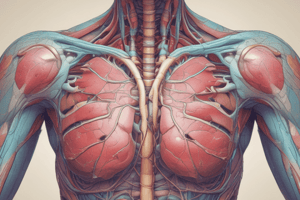Podcast
Questions and Answers
What are some common symptoms of thoracic outlet syndrome?
What are some common symptoms of thoracic outlet syndrome?
- Tingling fingers and numbness (correct)
- Stomach pain and indigestion
- Coughing and shortness of breath
- Blurred vision and dizziness
How is thoracic outlet syndrome typically diagnosed?
How is thoracic outlet syndrome typically diagnosed?
- Blood test
- Visual inspection
- Urine analysis
- Nerve conduction studies and MRI (correct)
What is a potential indicator of thoracic outlet syndrome when lifting the arm over the head?
What is a potential indicator of thoracic outlet syndrome when lifting the arm over the head?
- Stiffness in the arm (correct)
- Decreased blood pressure
- Improved posture
- Increased flexibility
Which age group is more commonly affected by thoracic outlet syndrome?
Which age group is more commonly affected by thoracic outlet syndrome?
What are the three main types of thoracic outlet syndromes?
What are the three main types of thoracic outlet syndromes?
Which of the following is NOT a diagnostic test for thoracic outlet syndrome?
Which of the following is NOT a diagnostic test for thoracic outlet syndrome?
What are some noninvasive treatment options for thoracic outlet syndrome?
What are some noninvasive treatment options for thoracic outlet syndrome?
When might surgery be considered as a treatment option for thoracic outlet syndrome?
When might surgery be considered as a treatment option for thoracic outlet syndrome?
How does physical therapy help postoperatively after surgery for thoracic outlet syndrome?
How does physical therapy help postoperatively after surgery for thoracic outlet syndrome?
What is the region involved in thoracic outlet syndrome where nerve and vascular compression occurs?
What is the region involved in thoracic outlet syndrome where nerve and vascular compression occurs?
What does the diagnosis of thoracic outlet syndrome typically involve?
What does the diagnosis of thoracic outlet syndrome typically involve?
Why do standardized approaches to thoracic outlet syndrome involve a mix of noninvasive and surgical interventions?
Why do standardized approaches to thoracic outlet syndrome involve a mix of noninvasive and surgical interventions?
Flashcards are hidden until you start studying
Study Notes
Thoracic Outlet Syndrome is a condition where nerves and blood vessels passing through the space between your collarbone and your first rib get compressed. This can lead to pain and discomfort in various parts of your body including the neck, shoulders, arms, chest, and hands. It's more common among women aged 35 to 50 years old, although it can happen to anyone. There are three main types of thoracic outlet syndromes: neurogenic, venous, and arterial. Here we will focus on symptoms, diagnosis, and treatment options.
Symptoms: If you have thoracic outlet syndrome, you might experience one or several symptoms like tingling fingers, numbness, weakness, cold or blue color in the hand, and muscle wasting in the forearm muscles. Additionally, some people may feel stiffness in their arm when they lift it over their head, which could indicate a problem with their blood circulation. In most cases though, these symptoms occur gradually rather suddenly.
Diagnosis: To diagnose thoracic outlet syndrome, doctors usually begin by performing a physical examination. Based on your medical history and physical findings, they may recommend additional tests such as nerve conduction studies, electromyography, magnetic resonance imaging (MRI), x-rays, ultrasound, computed tomographic angiography (CTA) scans, or functional magnetic resonance imaging (fMRI). These tests help narrow down what type of thoracic outlet syndrome you have so that proper treatments can be determined.
Treatment Options: For treating thoracic outlet syndrome, both noninvasive and invasive procedures exist depending on the severity of the condition. Some examples of noninvasive techniques include wearing a brace or splint, using heat packs or ice packs, taking medications, undergoing occupational therapy, or exercising regularly. Surgery might also be recommended if conservative measures don't work; this often includes removing part of one rib or cutting away tissue around the area where the compression occurs. Physical therapy postoperatively helps strengthen weakened areas and restore range of motion. Recovery time after surgery varies greatly from person to person.
In summary, thoracic outlet syndrome is characterized by symptoms involving various regions of the upper extremities due to nerve and vascular compression in the region known as the thoracic outlet. Proper diagnosis involves a combination of physical examination, lab tests, and possibly radiological testing. Standardized approaches to thoracic outlet syndrome involve a mix of noninvasive and surgical interventions based upon specific patient needs.
Studying That Suits You
Use AI to generate personalized quizzes and flashcards to suit your learning preferences.




